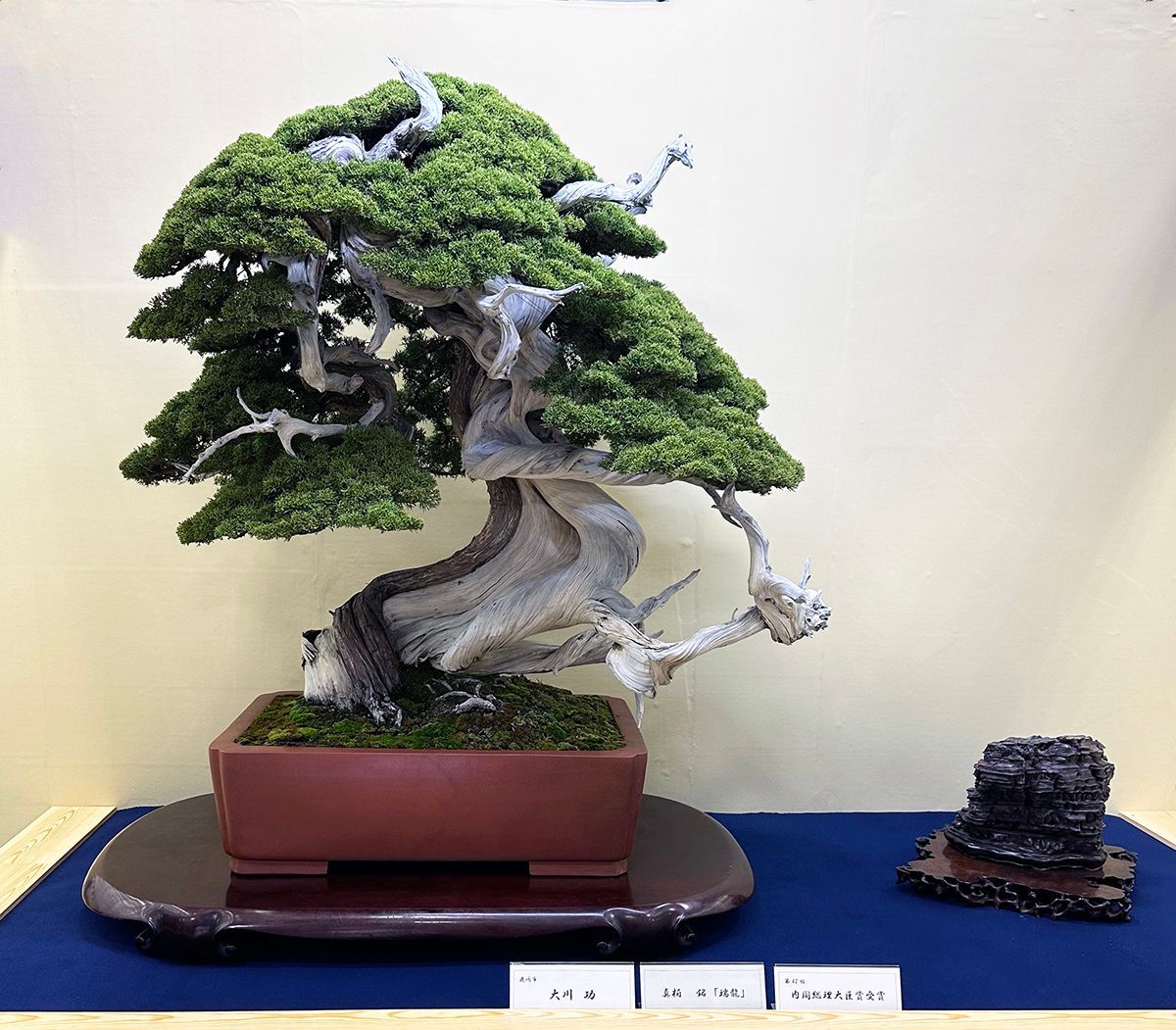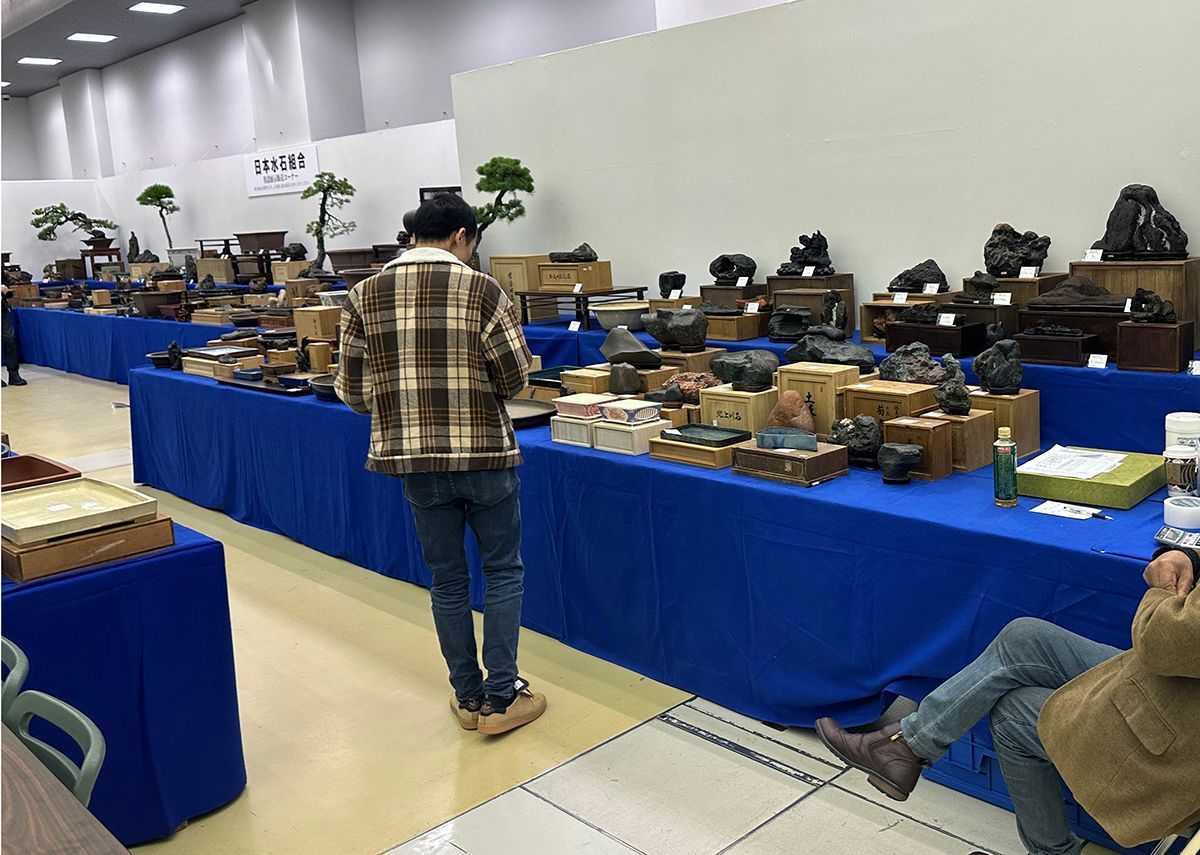Stones of the 43rd Taikanten, Kyoto, Japan, 2023
A discussion of the suiseki displayed at the 43th Taikanten in Kyoto, Japan
By Thomas S. Elias, February, 2024
A visit to the culturally rich and historically important city of Kyoto, Japan, is always rewarding. Autumn is my favorite time of the year to return to this ancient capital city when the striking array of autumn foliage colors comes into full display. This coincides with the largest and finest display of bonsai and suiseki in western Japan, the Taikanten or Grand View Exhibition, which is held in the city’s convention center, the Miyako Messe, in mid to late November each year. The 43rd Taikanten was held from November 24-27, 2023. This major event is organized and sponsored by the Nippon Bonsai Taikanten Organizing Committee, Kyoto City, the Kyoto Newspaper, KBS Kyoto Broadcasting Corporation, and the Japan Bonsai Cooperative.
This is truly an international event with over 120 Japanese entries and twenty additional displays by foreign collectors. Other countries represented in this year’s event were China, Germany, Italy, Korea, the Philippines, Thailand, and the United States. Additionally, nine invited special exhibits comprised the exhibition portion of the Taikanten. Adjacent to the stimulating and beautiful display is a large sales area where dealers from throughout Japan set up an array of trees, stones, pots, tools, display accessories, and other related and tempting items. Many nice bonsai, pots, and suiseki are gathered in an area designated for a live auction during the three-day event.
Visitors waiting for the opening of the Taikanten.

This spectacular bonsai and suiseki greets visitors as they enter the exhibition area.

A small portion of the sales area
One area in the public exhibition area of the Taikanten
Visitors to this event have much to learn. Not only can you see and study many fine examples of bonsai and viewing stones, but you can also note the methods used in displaying trees, stones, and exceptional pots. This is also an opportunity to talk with some of the most talented bonsai artists and suiseki connoisseurs attending this grand exhibition. These one-on-one discussions with knowledgeable experts to be one of the most rewarding aspects of participating in the Taikanten. This article will focus primarily on several of the excellent viewing stones in this 43rd exhibit.
An annual highlight of Taikanten is the inclusion of invitational exhibition stones. The organizers of this typically invite one or two holders of exceptional trees, pots, or stones to display at this event.
“Kien-hou” or Mt Kien, was one of the invited special display stones. This incredibly beautiful landscape suiseki originated in the Kamo River. According to records, it was formerly owned by Tokugawa Yoshinobu, the last Shogun of the Edo period, who provided its poetic name. The evocative surface texture and patina combined with its provenance make this an exceptional work of art.
Another special invitational exhibit stone was displayed by Funayama Akihide from Fukushima prefecture. This is a rare Tanba River reddish-purple cloud stone. The striking features of this stone give it the character that can illicit different feelings from different viewers.
An attractive Seta River Tiger-striped stone was one of many delightful rocks at the Taikanten. This stone was displayed by Kujo Michinari, Chief Priest of the Meiji Shrine in Tokyo. The distinct layers on the lower portion of this stone intersect with another series of steeply angled layers to form a plateau-type landscape. I find this sedimentary stone's layering, rich brownish color, and surface to be more evocative than its overall form. A gem of a Japanese suiseki!
The following stone is one of understated beauty that expresses the Zen aesthetic concept of Wabi. It is a Kurama stone from Kyoto Prefecture. Its poetic name is“Yama Kore Yama,” a Zen Buddhist term for “Mountain, this mountain.”
Several tokonoma-style displays featuring stones were given awards by the organizing committee for the Taikanten. These displays included a principal stone accompanied by accessory objects. The Nippon Suiseki Association Award was presented to Anthony Gedang for his display of a large, reddish-brown, vertically oriented Kotaro stone from Hokkaido.
The Nippon Bonsai Taikanten Organizing Committee’s Award was given to a display featuring a tunnel stone in a suiban, accompanied by a scroll depicting gentle water waves, and a bronze boat. The accessories help to convey a feeling of a tunnel along a sea coast that invites visitors to explore. This Kamo River stone was displayed by Thomas S. Elias.
A nice natural Neo Valley chrysanthemum flower stone display was presented with the Taikanten Award. Natural chrysanthemum flower stone like this one can be displayed in a suiban with sand. Polished examples of these pattern stones should be displayed only in carved wood bases.
Sato Mitsuo from Niigata displayed this landscape stone from the Ibi River in a dark blue ceramic tray with sand. One interpretation is a rocky coastal scene being slowly eroded by waves.
This handsome figure stone is from Italy and was displayed by Emilio Capozza. It is known as a Botero stone in its native country because of its resemblance to the works of the Columbian sculptor Fernando Botero.
Some viewers may have difficulty understanding how this rock can be called a Japanese suiseki. This low, flat rock was collected in the Seta River. The distinctive network pattern on the surface adds interest. The three layers of this sedimentary rock are subtle and understated and can evoke a peaceful, contemplative type of stone.
A collector from China entered this exhibit in the Taikanten. A large piece of Chinese turquoise is displayed between a Japanese white pine and a Japanese maple with red foliage. A scroll was hung behind the large mineral. It makes a colorful exhibit that does not conform to the guidelines in Katayama’s Keido School of Display. The Taikanten organizers allow for a greater range of display techniques and encourage newer experimental methods of displaying bonsai and viewing stones.
The Taikanten in Kyoto is my favorite major exhibition to attend for many reasons. This exhibition allows accessory items to be displayed with the bonsai and suiseki and even permits more contemporary displays. An array of important Buddhist temples, Shinto shrines, and several excellent museums are nearby. The presence of so many traditional crafts shops is an added benefit. Since Kyoto is a small city compared to Tokyo, moving from one location to another is easier and quicker. The Old Gion district and the abundance of fine restaurants make this city a must for anyone interested in Japanese culture.

